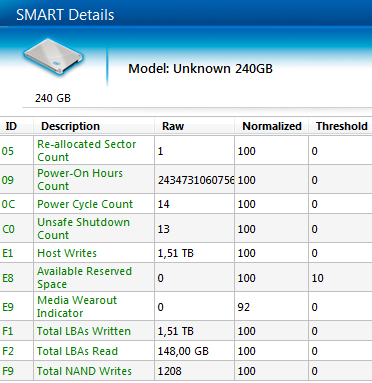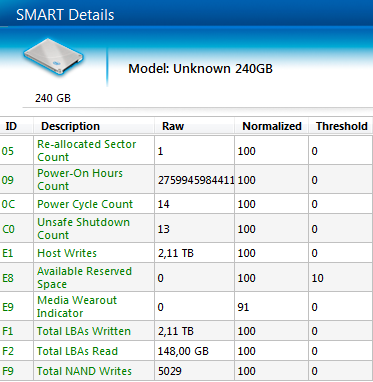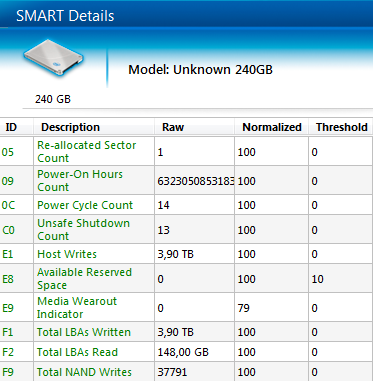Intel SSD 335 (240GB) Review
by Kristian Vättö on October 29, 2012 11:30 AM ESTTesting Endurance
We've mentioned in the past that NAND endurance is not an issue for client workloads. While Intel's SSD 335 moves to 20nm MLC NAND, the NAND itself is still still rated at the same 3,000 P/E cycles as Intel's 25nm MLC NAND. Usually we can't do any long-term endurance testing on SSDs for the initial review because it simply takes way too long to wear out an SSD. Even if you're constantly writing to a drive, it will take weeks, possibly even months for the drive to wear out. Fortunately Intel reports total NAND writes and percentage of lifespan remaining as SMART values that can be read using the Intel SSD Toolbox. The variables we want to pay attention to are the E9 and F9 SMART values, which represent the Media Wearout Indicator (MWI) and total NAND writes. Using those values, we can estimate the long-term endurance of an SSD without weeks of testing. Here is what the SMART data looked like before I started our endurance test:
This screenshot was taken after all our regular tests had been run, hence there are already some writes to the drive, although nothing substantial. What surprised me was that the MWI was already at 92, even though I had only written 1.2TB to the NAND. Remember that the MWI begins at 100 and then decreases down to 1 as the drive uses up its program/erase cycles. Even after it has hit 1, it's likely the drive can still withstand additional write/erase cycles thanks to MLC NAND typically behaving better than the worst-case estimates.
We've never received an Intel SSD sample that started with such a low MWI, indicating either a firmware bug or extensive in-house testing before the drive was sent to us.
To write as much as possible to the drive before the NDA lift, I first filled the drive with incompressible data and then proceeded with incompressible 4KB random writes at queue depth of 32. SandForce does real-time data compression and deduplication, so using incompressible random data was the best way to write a lot of data to NAND in a short period of time. I ran the tests in about 10-hour blocks, here is the SMART data after 11 hours of writing:
I had written another ~3.8TB to the NAND in just 11 hours but what's shocking is that the MWI had dropped from 92 to 91. With the SSD 330, Anand wrote 7.6TB to the NAND and the MWI stayed at 100, and that was a 60GB model; our SSD 335 is 240GB and thus it should be more durable (more NAND to write to). It's certainly possible that the MWI was at the edge of 92 and 91 after Intel's in-house testing, but I decided to run more tests to see if that was the case. Let's fast-forward 105 hours that I spent writing to the drive in total:
In a few days, I managed to write a total of 37.8TB to the NAND and during that time, the MWI had dropped from 92 to 79. In other words, I used up 13% of the drive's available P/E cycles. This is far from being good news. Based on the data I gathered, the MWI would hit 0 after around 250TB of NAND writes, which translates to less than 1,000 P/E cycles.
I showed Intel my findings and they were as shocked as I was. The drive had undergone their validation before shipping and nothing out of the ordinary was found. Intel confirmed that the NAND in SSD 335 should indeed be 3,000 P/E cycles, so my findings contradicted with that data by a fairly significant margin. Intel hadn't seen anything like this and asked me to send the drive back for additional testing. We'll be getting a new SSD 335 sample to see if we can replicate the issue.
It's understandable that the endurance of 20nm NAND may be slightly lower compared to 25nm even though they are both rated at 3,000 P/E cycles (Intel does have 25nm with 5,000 cycles as well) because 25nm is now a mature process whereas 20nm is very new. Remember that the P/E cycle rating is the minimum the NAND must withstand; in reality it can be much more durable as we saw with the SSD 330 (based on our tests its NAND was good for at least 6,000 P/E cycles). Hence both 20nm and 25nm MLC NAND can be rated at 3,000 cycles, although their endrudance in real world may vary (but both should still last for at least 3,000 cycles).
It's too early to conclude much based on our sample size of one. There's always the chance that our drive was defective or subject to a firmware bug. We'll be updating this section once we get a new drive in house for additional testing.














69 Comments
View All Comments
Bull Dog - Monday, October 29, 2012 - link
Do you have any hard data to back up this these assertions? Or are they just your unfounded opinions?I ask because the SSD 830 has a terrific reputation for being reliable. It has even demonstrated an exceptionally impressive lifespan over at XtremeSystems Forums.
kkwst2 - Monday, October 29, 2012 - link
Yeah, where's your data on that? I'm not aware of any data that suggests the 830 is less reliable in any way than Crucial or Intel. And my perception from experience and reviews are that Samsung has a significantly better reliability record than Sandforce. All vendors have had firmware issues to some degree, and Intel has had some pretty significant ones. The 8 MB issue on the 320 that caused data loss comes to mind.Samus - Monday, October 29, 2012 - link
Honestly the first Intel SSD I've come across dead was an SSD520 120GB, just wont detect by the system, clearly a Sandforce controller problem.I'd never seen an Intel SSD fail until now that (August 2012) and Intel has made a big mistake joining the likes of OCZ quality with its Sandforce marriage.
JonnyDough - Friday, November 23, 2012 - link
You must forget about all the issues that plague hard drives.MichaelD - Tuesday, October 30, 2012 - link
To what "Samsung drivers" are you referring? You don't need to load any drivers for this or any other SSD (at least in Windows 7, 8 and Server 2012). The driver is provided by Microsoft and has a date of 2006.And I'll note that Samsung SSDs are not plagued by the infamous "Sandforce controller bug." And that Samsung makes the controller the NAND and everything else in the SSD.
So how again, is it less reliable than other SSDs?
centosfan - Wednesday, October 31, 2012 - link
I don't think you know what you are talking about. I have two Samsung 830's and use them everyday and push they quite hard. Haven't had 1 single issue. I haven't heard of any problems with them either.hrga - Thursday, November 1, 2012 - link
It all depends about the market Samsung 830 128GB is here 170USD while 256GB version is 400USD so they aint affordable at all. While Intel 520 series 240GB costs 350USD and 120GB 180USD respectivelyseapeople - Friday, November 2, 2012 - link
So $170 and 128GB is less affordable than $180 and 120GB? You live in strange world.djshortsleeve - Monday, October 29, 2012 - link
I dont see the need for all these various models. Make a value drive and a high end one. You either buy cheapest or best.Kristian Vättö - Monday, October 29, 2012 - link
That's essentially what Intel offers. SSD 335 is the value drive, whereas the successor of SSD 520 will be the high-end one. SSD 335 and 330 are basically the same and 335 will replace the 330 sooner than later (I'm hearing Q1'13 for the other capacities).